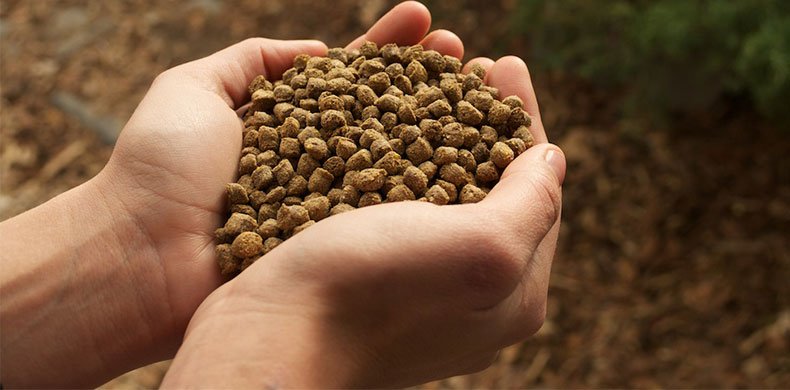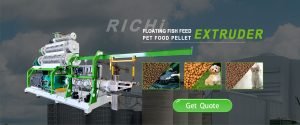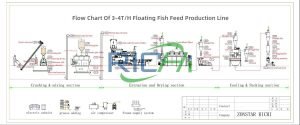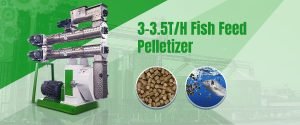Fish feed pellet machines are primarily designed for creating feed for aquatic species, but there’s a growing interest in their potential for processing livestock and poultry feed. This article delves into the feasibility of using fish feed pellet machines for non-aquatic animal feeds, the necessary modifications, and the advantages and challenges associated with this approach.
Capabilities of Fish Feed Pellet Machines
Fish feed pellet machines have several features that can be advantageous for processing livestock and poultry feed:
- Extrusion Technology: Many fish feed machines utilize extrusion, which is beneficial for creating certain types of livestock and poultry feeds.
- Temperature Regulation: Precise control of temperature during processing is essential for producing quality feeds for both aquatic and terrestrial animals.
- Moisture Control: The ability to manage moisture content is vital for all forms of animal feed production.
- Versatile Pellet Sizing: Fish feed machines can produce pellets in various sizes, accommodating the needs of different livestock and poultry species.
- Ingredient Adaptability: These machines can generally handle a broad range of ingredients commonly used in both aquatic and terrestrial animal feeds.
Types of Fish Feed Pellet Machines
Various types of fish feed pellet machines have differing levels of suitability for producing livestock and poultry feed:
- Dry Type Fish Feed Extruder: This type can be adapted for certain livestock and poultry feeds, particularly for smaller-scale operations.
- Wet Type Fish Feed Extruder: More versatile and often suitable for a wider range of livestock and poultry feeds with proper adjustments.
- Twin-Screw Extruder: Highly adaptable, capable of processing various feed types, including many livestock and poultry formulations.
- Ring Die Pellet Mill: Commonly used in both aquatic and terrestrial feed industries, this mill is well-suited for livestock and poultry feed production.
- Flat Die Pellet Mill: Applicable for both fish and terrestrial animal feeds, particularly in smaller-scale settings.
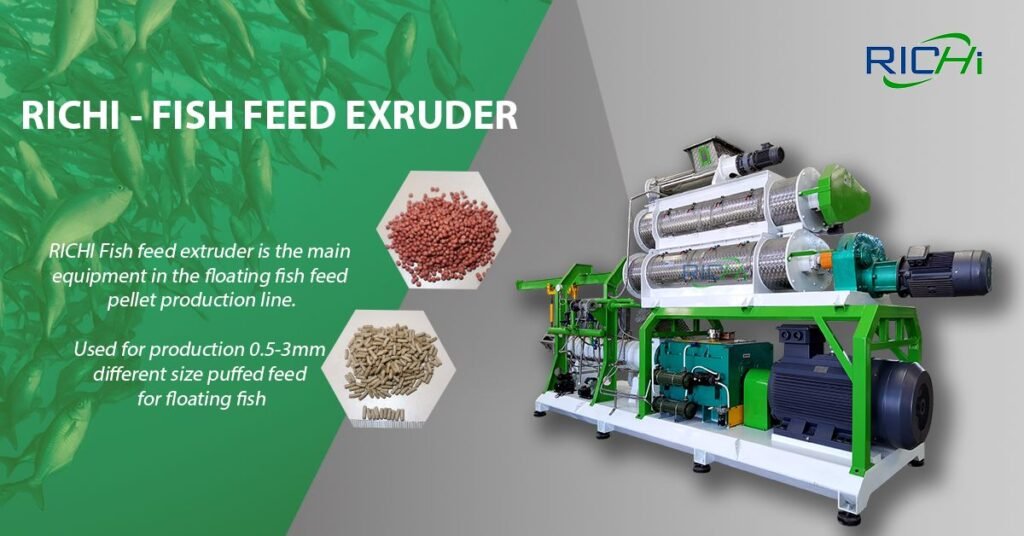
Required Modifications for Livestock and Poultry Feed Production
To effectively utilize fish feed pellet machines for livestock and poultry feed, several adaptations may be needed:
- Die Adjustments: Different die sizes and configurations may be necessary to accommodate various livestock and poultry feed types.
- Conditioning Process: Modifications to the conditioning process may be required to meet the specific needs of non-aquatic feeds.
- Cooling Systems: The cooling process might need adjustments, as livestock and poultry feeds often have different cooling requirements compared to fish feed.
- Formulation Changes: Feed formulations must be adapted to fulfill the nutritional needs of livestock and poultry.
- Processing Parameters: Adjustments in temperature, pressure, and retention time may be necessary for optimal production of livestock and poultry feed. (Related post:feed mill pellet machine )
Types of Livestock and Poultry Feed Processable
With the right modifications, fish feed pellet machines can potentially produce various types of livestock and poultry feeds, including:
- Cattle Feed: Formulations for both dairy and beef cattle.
- Poultry Feed: Suitable for broilers, layers, and other poultry species.
- Swine Feed: Various formulations catering to different growth stages.
- Sheep and Goat Feed: Both maintenance and production feeds.
- Horse Feed: Including formulations for performance and maintenance.
- Rabbit Feed: Pellets tailored for both commercial and pet rabbits.
Advantages of Using Fish Feed Machines for Livestock and Poultry Feed
Utilizing fish feed pellet machines for producing livestock and poultry feed offers several benefits:
- Versatility: The ability to create multiple types of animal feed with a single machine.
- Cost-Effectiveness: Potentially lower equipment costs for facilities that produce both aquatic and terrestrial feeds.
- Space Efficiency: A compact solution for operations with limited space.
- Technological Benefits: Advanced features in fish feed machines may enhance livestock and poultry feed production.
- Experimental Flexibility: Easier experimentation with new feed formulations across different animal types.
Limitations and Challenges
Despite their adaptability, fish feed pellet machines also come with certain limitations and challenges:
- Capacity Limitations: Some fish feed machines may have lower production capacities compared to dedicated livestock feed equipment.
- Increased Wear: Processing diverse feed types may lead to more wear on machine components.
- Regulatory Compliance: Ensuring adherence to different feed regulations for both aquatic and terrestrial animals can be complex.
- Optimization Difficulties: Achieving optimal efficiency for all feed types may present challenges.
- Cross-Contamination Risks: Careful cleaning and management are essential when switching between producing aquatic and terrestrial feeds.
Case Studies and Industry Examples
Several examples highlight the successful adaptation of fish feed equipment for livestock and poultry feed:
- A small-scale farm in Asia reported using a twin-screw extruder to produce both fish and poultry feed, resulting in reduced equipment costs and improved operational flexibility.
- A South American feed mill adapted its wet type fish feed extruder to produce specialty horse feed, leveraging the machine’s precise gelatinization control for enhanced feed digestibility.
- A European research facility utilized a versatile fish feed pellet machine for comparative studies on nutritional formulations across aquatic and terrestrial species.
Industry Trends
The trend of using fish feed pellet machines for livestock and poultry feed aligns with several industry developments:
- Growing demand for flexible, multi-purpose feed production equipment.
- Increasing interest in cross-species nutritional research and innovative feed formulations.
- A focus on cost-effective solutions for small to medium-scale feed producers.
Conclusion
Fish feed pellet machines can effectively process livestock and poultry feed, providing a versatile solution for animal feed production. While originally designed for aquaculture, their capabilities in extrusion, temperature regulation, and pellet formation make them adaptable for a variety of animal feed types.
However, leveraging fish feed equipment for livestock and poultry feed production necessitates careful consideration of necessary modifications, potential limitations, and compliance with regulations. Operations interested in this approach should assess the specific requirements of the intended feed types and consult with equipment manufacturers to ensure proper adjustments and optimal performance.
The ability to produce both aquatic and terrestrial animal feeds with a single machine can lead to significant advantages in versatility, cost savings, and operational efficiency. As the animal feed industry evolves, with an increasing emphasis on adaptability and efficiency, the multifunctional use of feed production equipment, such as fish feed pellet machines, is likely to become more prevalent, especially among smaller operations or those seeking to diversify their feed production capabilities.
Ultimately, while fish feed pellet machines present a viable option for processing livestock and poultry feed, the decision to utilize them for this purpose should be based on a comprehensive evaluation of production requirements, equipment capabilities, and long-term operational goals.
